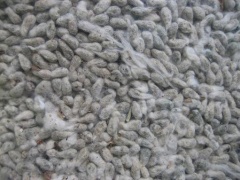Cottonseed
| Infobox on Cottonseed | |
|---|---|
| Example of Cottonseed |  |
| Facts | |
| Origin | West Africa, China |
| Stowage factor (in m3/t) |
|
| Humidity / moisture | See text |
| Ventilation | - |
| Risk factors | See text |
Cottonseed
Description / Application
Cotton is a soft, fluffy staple fibre that grows in a boll, or protective capsule, around the seeds of cotton plants of the genus Gossypium. The fibre is almost pure cellulose. Under natural condition, the cotton balls will tend to increase the dispersion of the seeds.
The cottonseed which remains after the cotton is ginned is used to produce cottonseed oil, which, after refining, can be consumed by humans like any other vegetable oil. The cottonseed meal that is left generally is fed to ruminant livestock; the gossypol remaining in the meal is toxic to monogastric animals. Cottonseed hulls can be added to dairy cattle rations for roughage.
Shipment / Storage / Risk factors
Cottonseed is shipped in bulk or in bags.
Cottonseed is generally classified as ‘white’ or ‘black’. The white variety has the woolly lint adhering to the seed, while the black has practically no lint adhering to it and the black and brown husk of the seed itself is visible.
Cottonseed is liable to heat from inherent vice and the extent of such internal damage is ascertainable by crushing the seed and estimating the extent of the damage by the discoloration of the seed.
The lint on the white variety is liable to absorb moisture, thereby creating heat with subsequent decomposition.
Cottonseed is liable to spontaneous combustion, especially if loaded during wet or damp weather. Long storage may affect the oil content, at the same time increasing the acidity content.
Average moisture content for Tanzanian cottonseed is approx. 9%; average for Chinese cottonseed is 11,5%, and it is anticipated that during a standard marine voyage up to 2,5% moisture can be lost, reducing the landed moisture content to approx. 9%.
Cottonseed cake and meal
Cottonseed cake is shipped in bulk or in bags and is used as an animal feed or fertiliser ingredient. Bulk shipments in cake form are subject to loss of weight during shipment and discharge owing to breaking and powdering. Serious damage to cargo can be caused by dampness or ship’s sweat due to improper ventilation. Moisture causes the cake to mould, which spreads rapidly. This condition can usually be detected by a strong, sour odour. Bags are very often stained by their own contents. Liable to spontaneous combustion when wetted. Susceptible to damage by taint if stowed with or near odorous cargoes. Subject to loss in weight due to drying out.
Cottonseed oil
Obtained from the cottonseed by hot-pressure or solvent extraction. Shipped in bulk and sometimes in drums. Used in the manufacture of soap and cosmetics, as a leather dressing and in waterproofing and lubricating compositions.
When shipped in bulk it is often necessary for heating coils to be fitted as the oil solidifies at approx. 10°C, but should the temperature approach boiling point, the oil will deteriorate.
Cottonseed residue
Residue from cottonseed after extraction of oil by the continuous screw process. Contains about 5% oil. Shipped in bulk or in bags. Used as an animal feed or in the manufacture of fertilisers.
Is liable to heat and if badly stowed may be subject to spontaneous combustion.
Has a tendency to increase in weight with absorption of moisture but may also lose weight by drying out. Liable to damage by tainting if stowed near or with odorous cargoes such as skins or hides. Moist cargoes and rain may cause mould growth.
See also advice on overseas shipment of Seedcake and Expellers and Extractions and Bulk Oils and Fats.
Check the IMDG Code (spontaneously combustible products).











